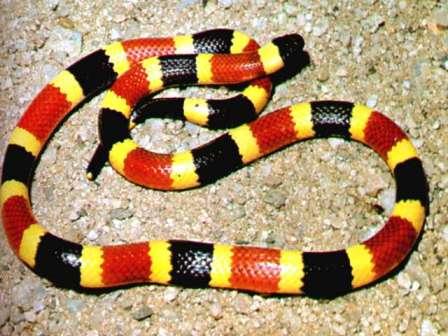
I swear to gods that snake is not venomous. It does, however, want you to think that it is; tri-color milk snakes (Lampropeltis triangulum, various subspecies) utilize Batesian mimicry, copying the venomous coral snake's banded pattern. The milk snake itself is not venomous; it is a beneficial snake that not only kills rodents, but, like many king snakes, eats other snakes. (If you want to see a California king snake (L. getula) doing what it does best, click this link.) Milk snakes are found in forests and biology books throughout the U.S., parts of Canada, and Central America.

As you can see, this little snake is not venomous. Either that, or the guy holding it is crazy.
It is suspected that, due to the coral snake's fatal venom (thus eliminating any animal stupid enough to touch it), both coral snakes and milk snakes are instead copying a less-venomous species. (This is refuted by the mimicry of other milk snakes to other venomous species; maybe my textbook was outdated and/or wrong. It is, however, supported by the idea that most Batesian mimics copy distasteful/painful species rather than venomous ones. I'm really on the fence, here.) Milk snakes aren't the only ones in on this banded mimicry deal, either; there is one type of caterpillar that bears a striking (...bad pun) resemblance to a coral snake (from Asia, apparently). There are copies of copies of copies of this banded pattern in nature - hint hint, gaming companies.

THIS can kill you.
So, how do you tell the non-toxic snakes from the poisonous ones? If you are from the U.S., you might already know this one: "Red next to yellow will kill a fellow; red next to black is a friend of Jack." There are a few other mnemonic devices, but the basic idea is that red next to black is safe. You can also look at things like band width, but really, it's better to just leave the snake alone. Coral snakes, despite being deadly, are reclusive creatures and prefer not to be disturbed; milk snakes are helpful and should be left to their own devices.

Milk snakes are so called because they are easy to find around barns, and were once thought to suck milk from a cow's udders. Don't try that at home; even though the Greeks and Romans left out offerings of milk for snakes, it really is not good for them and the milk snake cannot suck milk out of cow udders. Plus, what did I say about cows and milk when I did aurochs?
Milk snakes are also popular in the exotic pet trade. Milk snakes can hybridize with corn snakes (a risky venture, given that they even eat their own species), other milk snakes and king snakes for some really trippy combos. More importantly, within milk snakes (especially the Pueblan milk snake), you have albino, tangerine, 'Oreo' and 'Halloween' color morphs.
From Milksnakes.com. I swear I would have self-hosted if Blogger pic hosting was not so slow.
Happy early Halloween, all! I have something even trippier for Halloween Day!




No comments:
Post a Comment